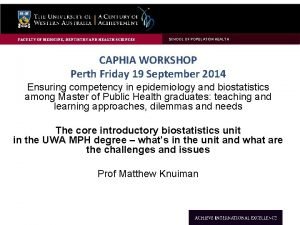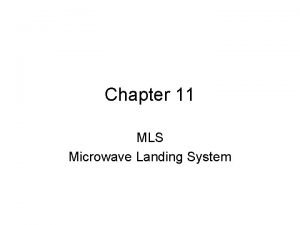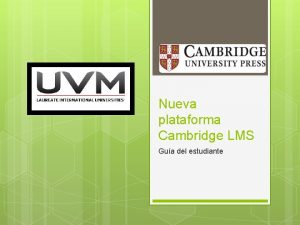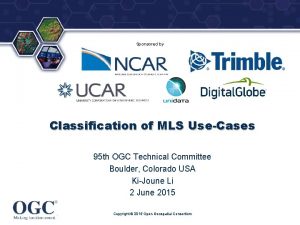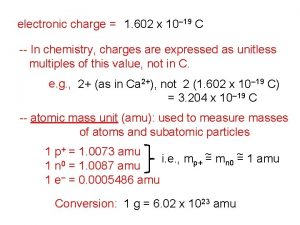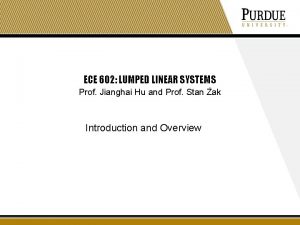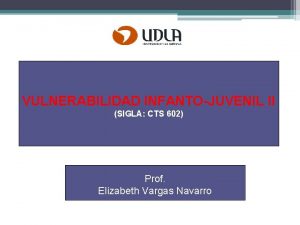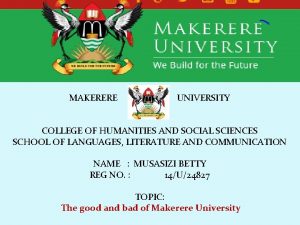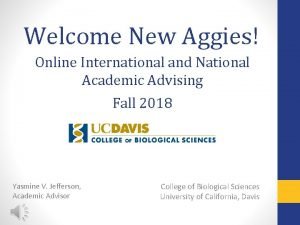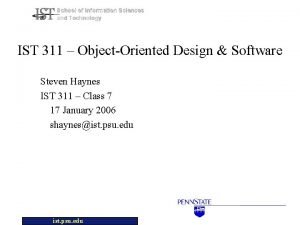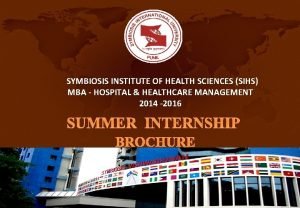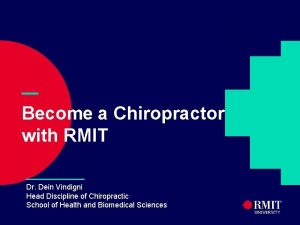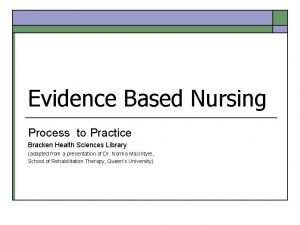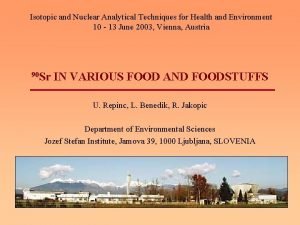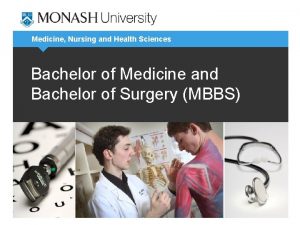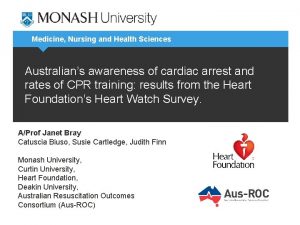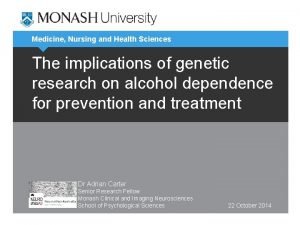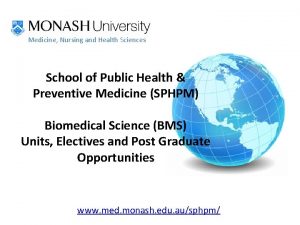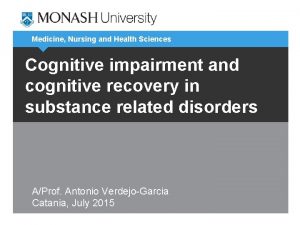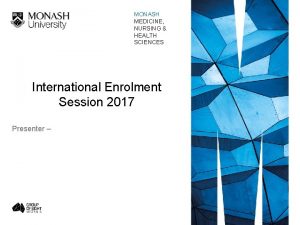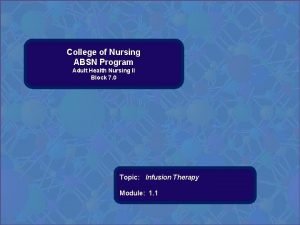COLLEGE OF MEDICINE NURSING HEALTH SCIENCES MLS 602







































- Slides: 39

COLLEGE OF MEDICINE, NURSING & HEALTH SCIENCES MLS 602 : Medical Microbiology LECTURE 8: Introduction to Parasitology Ms. Edwina Razak Edwina. Razak@fnu. ac. fj. 1/15/2022 MLS 602 EDWINA RAZAK 1

Expected Student Outcomes o. Define parasitology. o. Outline the basic taxonomy and classification of parasites. o. Explain the basic structure and reproduction processes of parasites o. Describe the clinical significance of knowing about parasites o. Outline the clinical laboratory diagnosis of common blood, tissue and gastrointestinal parasites. 1/15/2022 MLS 602 EDWINA RAZAK 2

What is Parasitology • Scientific study of parasites based on their replication, metabolism, growth and infectivity. What are parasites? • Organisms that live on/in another species, [known as the host] from which it obtains nutrients for growth and survival. • The host does not always benefit from the association and is often harmed by it. • A parasite which lives in or on the body of the host is called Endoparasite (in the body e. g. protozoa and helminthes) or Ectoparasite (outside of the body e. g. arthropods) 1/15/2022 MLS 602 EDWINA RAZAK 3

Structure of parasites • Are multicellular eukaryotes with variable & complex structures containing – nuclei, nucleoli, – nuclear membrane, – mitochondria, – ribosomes, – endoplasmic reticulum 1/15/2022 MLS 602 EDWINA RAZAK 4

1/15/2022 MLS 602 EDWINA RAZAK 5

Taxonomy And Classification Protozoan (Unicellular- composed of one cell) §Amoeba (sarcodina) §Flagellates (mastigophora) §Ciliates (ciliophora) §Sporozoans (apicomyplexa) Metazoan (Multicellular – composed of many cells) Helminths §Nematodes- roundworms §Trematodes- flukes §Cestodes - flatworms Exoparasites §Arthropods § Ticks and mites 1/15/2022 MLS 602 EDWINA RAZAK 6

1/15/2022 MLS 602 EDWINA RAZAK 7

Definitions Host - the partner providing food and/or protection. Some parasites require more than one host to complete their life cycle; Or may not require a host during some stage(s). Reservoir (carrier) host - the host harboring a parasite in nature, serving as a source of infection for other susceptible hosts. Reservoir hosts show no sign or symptom of disease. Definitive host - the host in which sexual maturity and reproduction takes place. Paratenic host - an accidental host serving as a holding place for a parasite. Intermediate host - the host in which the parasite undergoes essential development. 1/15/2022 MLS 602 EDWINA RAZAK 8

Definition Vector - “carrier” of a parasite from A parasite is successful - when one host to another. Often an insect. it is in delicate balance with the host. If the balance is upset, the Symbiosis - “living together, ” a close host may destroy or expel the association between two organisms. parasite; If the host is overly damaged, it may die - as will the Mutualism - both organisms are parasite. benefited (bacteria in bowel). Commensalism - “eating at the same table; ” One organism is benefited, the other is unaffected. Parasitism - one organism is benefited at the expense of another (the host). 1/15/2022 Parasitology is important because this balance is not always maintained. MLS 602 EDWINA RAZAK 9

Parasitic Damage to Host Trauma - damage to tissues, intestine, liver, eye. Lytic action - activity of enzymes elaborated by organism. Tissue response - localized inflammation, eosinophilia. Blood loss - heavy infection with hookworm may cause anemia. Secondary infections - weakened host susceptible to bacterial infection, etc. 1/15/2022 Modes of Infection Filth-borne or contaminative where personal hygiene and community sanitation lacking. Infectious stages remain viable for long periods in contaminated soil. Soil or water-borne - water or dirt which can contain eggs, etc. ; Larvae can penetrate skin of bare feet or enter skin in infested water. Food-borne - inadequately cooked beef, pork, fish, shell fish. Arthropod-borne - the most difficult of all to control. Mosquitoes transmitting malaria, etc MLS 602 EDWINA RAZAK 10

Reproduction 1/15/2022 MLS 602 EDWINA RAZAK 11

Reproduction Complex cycles: hookworms Roundworms and Ø Rhabdiform larval stage- enters host , via blood stream to lungs , coughed out to trachea and through esophagus to intestine ØHelminths- Ingested or injected by insects that migrates to tissues, liver, skin, muscles, lymphatics or skin from the lungs. 1/15/2022 MLS 602 EDWINA RAZAK 12

Pathogenicity o have few known pathogenic mechanism than bacteria o. For example: Surface attachment mechanism in cestodes having hooks and suckers. o. Often less invasive o. Few cytotoxins o. Able to avoid host defense by ingenious mechanism e. g. Schistosomes use host plasma proteins to cover them from host immune responses o. Large tissue tropism 1/15/2022 MLS 602 EDWINA RAZAK 13

Host Defense q. Chronic disease and chronic inflammation q. Eosinophilia due to parasite surface polysaccride and glycoproteins q. Ig. E increased to assist killing parasites q. Up-regulate antibody production and cell mediated immunity but are relatively ineffective 1/15/2022 MLS 602 EDWINA RAZAK 14

Protozoan (single celled) § Unicellular, non photosynthetic §Various shape types: round, spherical and spindle §Cell membrane with no cell wall All protozoans have 2 important stages of life: Trophozoite – active, free swimming state of protozoan Cyst – dormant phase. In most cases this is the infective stage. 1/15/2022 MLS 602 EDWINA RAZAK 15

Classification of Protozoa Intestinal Genitourinary Trichomonas vaginalis Haemopoetic (Blood parasites) 1/15/2022 MLS 602 EDWINA RAZAK 16

Intestinal Protozoan § Classified according to their movement §Reproduce by simple binary fission of trophozoites or by formation of trophozoites within the multinucleate cyst. §Cyst and trophozoites are passed in stool specimen § Causes amoebiasis and encephalitis 1/15/2022 MLS 602 EDWINA RAZAK 17

Amoeba Sarcodina the largest phylum (11, 500 living species) of protozoans. It comprises the amoebas and related organisms; which are all solitary cells that move and capture food by means of pseudopods, temporary extensions of the cell. Most sarcodia are free living; others are parasitic. One of these parasites is the causative organism of amebic dysentery. 1/15/2022 MLS 602 EDWINA RAZAK 18

Entamoeba histolytica Epidemiology Lab Diagnosis Ø Occurs worldwide Ø Examination of a fresh dysenteric fecal specimen or rectal scraping for trophozoite stage. Pathology and Clinical manifestations ØMotile amoeba containing red Ø The most common pathogenic of cells are diagnostic of amoebic all dysentery ØCauses amoebic dysentery ØLiver abscess is used to cyst and trophozoite identification ØHepatic abscess ØChronic infections may last for years; often confused with colitis and cancer 1/15/2022 MLS 602 EDWINA RAZAK 19

Pathogenesis 1/15/2022 MLS 602 EDWINA RAZAK 20

Other Protozoa LAB DIAGNOSIS NAEGLERIA FOWLERI o Tissue dwelling amoeboflagellate o CSF contains motile amoeba o. Amoeboid form is found in tissues Life cycle o Gains entry via nasal mucosa usually during a swimming event o. Moves through olfactory nerve gaining access to brain o. Causes parasitic meningitis and are fatal 1/15/2022 MLS 602 EDWINA RAZAK 21

Acanthamoeba o the etiology of amoebic keratitis and encephalitis. o. Encephalitis is caused by Acanthamoeba entering cuts or through the nares and spreading to the central nervous system. o In eye lesions the infection resembles herpes virus infection 1/15/2022 MLS 602 EDWINA RAZAK 22

Flagellates o. Mastigophora are propelled by one or more flagella o Multiply by longitudinal binary fission o. Shape like a “vase” and move by one or more “whiplike” undulating flagella. o. Each flagellum have microtubule arrangement which forces water outward to provide locomotion. 1/15/2022 Three groups of flagellates: o. Luminal flagellates e. g Giardia lamblia , Dientmoeba fragilis o. Hemoflagellates e. g Trypanosoma species. Leishmania species. o. Genital flagellates e. g. Trichomonas vaginalis MLS 602 EDWINA RAZAK 23

Giardia lamblia Morphology - very distinctive. Dorsal-ventrally flattened, and Bi-laterally symmetrical. Cyst - 9 x 12 micrometers and contain 2 to 4 nuclei; parabasal bodies are present. Each cyst gives rise to two trophozoites during excystation in the intestinal tract. Trophozoite - Four pairs of flagella - one pair located anterior, two pair located ventrally, and one pair located posteriorly. An axostyle and parabasal bodies are present. 1/15/2022 MLS 602 EDWINA RAZAK 24

Giardia Laboratory diagnosis � identification of cysts or trophozoites in stool specimens or duodenal contents. � stool specimen per day for 3 days is important � duodenal aspiration, string test (entero-test), or biopsy of the upper small intestine can be examined. � conventional microscopy, several immunologic tests can be implemented for the detection of parasitic antigens. Mode of transmission • Fecal-oral route 1/15/2022 MLS 602 EDWINA RAZAK 25

Giardia- “cross eyed tennis racket” Pathogenesis � Gastric acid stimulates excystation, with the release of trophozoites in duodenum and jejunum. � trophozoites can attach to the intestinal villi by the ventral sucking discs without penetration of the mucosa lining. � only feed on the mucous secretions. � Metastatic spread of disease beyond the GIT is very rare. 1/15/2022 MLS 602 EDWINA RAZAK 26

Genital Flagellates: Trichomonas vaginalis Characteristics üUndulating membrane protoplasmic membrane with flagellar rim extending out like a fin along outer edge of body. üFlagella - several in a tuft, provides locomotion. üAxostyle - functions for support. üCosta - firm rod-like structure running along base of the undulating membrane. üCytostome - rudimentary mouth. 1/15/2022 Features � pear-shaped organism with a central nucleus and two pairs of anterior and one posterior flagella; has an axostyle � undulating membrane extends about two-thirds of its length. � Thrives in an acidic environment of human vagina. MLS 602 EDWINA RAZAK 27

Trichomonas vaginalis Mode of infection - sexual intercourse or fomites. q. Trichomoniasis is primarily an infection of women's vaginal and urinary tracts. Lab Diagnosis qidentification of trophozoites in body fluids (HVS or Urethral wet mounts of discharges) or on pap smears. 1/15/2022 MLS 602 EDWINA RAZAK 28

Haemoflagelates Leishmania Species �Rare disease �transmitted by sand flies (Phlebotomus), can lead to visceral, cutaneous and mucocutaneous leishmaniasis �amastigote (aflagellar) and promastigote (flagellated) in their life cycle. 1/15/2022 MLS 602 EDWINA RAZAK 29

Visceral leishmaniasis Leishmania donovani Important features- the natural habitat of is the reticuloendothelial system of the viscera, in which the amastigote multiplies by simple binary fission. � Kala-azar meaning “black fever”. � Infection of WBC and is accompanied by fever, swollen spleen and liver and progressive anaemia. 1/15/2022 Laboratory diagnosis §Examination of tissue biopsy, spleen aspiration, bone marrow aspiration or lymph node aspiration in properly stained smear (e. g. Giemsa stain). � The amastigotes appear as intracellular & extra cellular L. donovan (LD) bodies. � Serologic testing is also available. MLS 602 EDWINA RAZAK 30

Cutaneous Leishmaniasis (Oriental sore) � Disfiguring cutaneous disease. � L. tropica minor - dry or urban cutaneous leishmaniasis � L. tropica major - wet or rural cutaneous leishmaniasis � L. aethiopica - cutaneous leishmaniasis � Gradually the ulcer becomes hard and crusted and exudes a thin, serous material. � At this stage, secondary bacterial infection may complicate the disease. � a red papule, appears at the site of the fly’s bite. This lesion becomes irritated, with intense itching, and begins to enlarge & ulcerate. 1/15/2022 MLS 602 EDWINA RAZAK 31

Mucocutaneous Leishmaniasis Clinical disease: Pathogenesis �Leishmania mexicana complex- Cutaneous leishmaniasis. �Leishmania braziliensis complexmucocutaneous or cutaneous same as oriental sore. � some of the strains tend to invade the mucous membranes of the mouth, nose, pharynx, and larynx. 1/15/2022 � lesions are confined to the skin in cutaneous leishmaiasis and to the mucous membranes, cartilage, and skin in mucocutaneous leishmaniasis. � necrotic ulcer forms at the bite site which become superinfected by bacteria. Laboratory diagnosis • Demonstration of the amastigotes in properly stained smears from touch preparations MLS 602 EDWINA 32 of. RAZAK ulcer biopsy specimen.

Trypanosoma � African sleeping sickness or Pathogenesis � trypomastigotes spread from the Chagas disease skin through the blood to the lymph node and the brain. � Transmitted by tsetse flies or � progresses to coma as a result of reduviid bugs demyelinating encephalitis � Trypanosoma brucei complex Laboratory Diagnosis – African trypanosomiasis � Examination of thin and thick (sleeping sickness) films, in concentrated anticoagulated blood � Trypanosoma cruzi – preparations, and in aspiration American trypanosomiasis from lymph nodes and concentrated spinal fluid (CSF). (Chagas’ disease) � Wet preparations should also be � elongated spindle-shaped examined to look for motile organisms. body that more or less tapers at both ends � centrally situated nucleus, a 1/15/2022 33 kinetoplast posterior to MLS 602 EDWINA RAZAK

Tsetse Fly 1/15/2022 MLS 602 EDWINA RAZAK 34

1/15/2022 MLS 602 EDWINA RAZAK 35

CILIATES – hair like projections around cell to move Balantidium coli � Commonly found in animal intestinal tracts � Humans become infected by consuming food or water contaminated with feces containing cysts � Trophozoites attach to the mucosal epithelium lining the intestine � B. coli infections are 1/15/2022 MLS 602 EDWINA RAZAK 36

Other Intestinal Protozoa Cryptosporidium parvum Isospora belli � Site of infection - � Definitive host - humans. primarily an intestinal infection, can become upon initial infection when systemic in AIDS sporozoites invade the patients. intestinal epithelium and � Identification - oocysts multiply. are 2 - 5 microns in � Sporogony - progeny of diameter; do not stain asexual reproduction initiate with iodine; and are aciddevelopment into gametes fast. (male & female); fertilized � person-to-person, fecalgametes develop into oocysts oral route transmission � Schizogony - takes place which are passed as the infectious stage in the feces. 1/15/2022 MLS 602 EDWINA RAZAK 37

Cryptosporidium parvum �Pathology - most infections cause severe diarrhea. In the immunosuppressed patient, the condition is protracted and life threatening. There is no drug effective against this parasite 1/15/2022 MLS 602 EDWINA RAZAK 38

Summary 1/15/2022 MLS 602 EDWINA RAZAK 39
 Mrbs scholarship
Mrbs scholarship Faculty of medicine dentistry and health sciences
Faculty of medicine dentistry and health sciences Pet 3351 ucf
Pet 3351 ucf Human sciences
Human sciences Mls sife screener
Mls sife screener Ils mls
Ils mls Denee evans
Denee evans Vls shot
Vls shot Lds seminary attendance requirements
Lds seminary attendance requirements Cambridge lms
Cambridge lms Mls fundação
Mls fundação Mls classification
Mls classification Mls rezistence
Mls rezistence Filler 602
Filler 602 1 602 x 10^-19
1 602 x 10^-19 Goremote purdue
Goremote purdue Kreis 602
Kreis 602 E=1 602*10
E=1 602*10 1 602 x 10^-19
1 602 x 10^-19 Tu payas mon salut paroles
Tu payas mon salut paroles Modelos explicativos del maltrato infantil
Modelos explicativos del maltrato infantil 1 602 x 10^-19
1 602 x 10^-19 602 200 000 000 000 000 000 000 in scientific notation
602 200 000 000 000 000 000 000 in scientific notation Bev kreis 602
Bev kreis 602 602 sextillion
602 sextillion Queens high school for sciences at york college
Queens high school for sciences at york college College of humanities and social sciences
College of humanities and social sciences Aggie advising college of biological sciences
Aggie advising college of biological sciences College of information sciences and technology
College of information sciences and technology College of social sciences glasgow
College of social sciences glasgow College of liberal arts and sciences uf advising
College of liberal arts and sciences uf advising Usf college of behavioral and community sciences
Usf college of behavioral and community sciences Kavneet hayre
Kavneet hayre Purdue health sciences
Purdue health sciences Observational health data sciences and informatics
Observational health data sciences and informatics School of health and biomedical sciences rmit
School of health and biomedical sciences rmit Cleveland health sciences library
Cleveland health sciences library University of health sciences lahore events
University of health sciences lahore events Bracken health sciences library
Bracken health sciences library Health and environmental sciences institute
Health and environmental sciences institute

